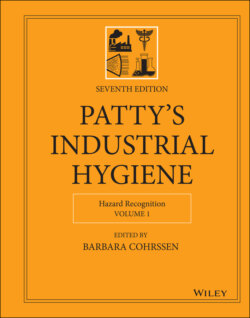Читать книгу Patty's Industrial Hygiene, Hazard Recognition - Группа авторов - Страница 20
2.5 1960s: Certification of Industrial Hygienists Provides a Mark of Professional Recognition
ОглавлениеIn 1959, the Certification Committee of the AIHA recommended the establishment of a separate Board for certification of industrial hygienists, which became the American Board of Industrial Hygiene (ABIH). The 1960s saw the certification of 13 industrial hygienists, with 483 grandfathered by 1962. The first Certified Industrial Hygienist (CIH) examinations were held in Cincinnati, Ohio in 1963.
In the 1960s, there was a great increase in the sampling of workplace exposures. Sherwood and Greenhalgh were considered the first to build a practical personal sampling pump in 1960 (40),(41). The methods of sample analysis also greatly improved over the course of the 1960s. A surge of improved and sophisticated techniques for quantifying workers' exposures to health stress agents also generally took place in the 1960s. This progress applied to both sample collection and analytical techniques which resulted in much lower levels of exposure to specific agents being detected and quantified. There also began a dramatic increase in toxicological and epidemiological studies by government, industry, universities, and foundations, directed to obtaining data upon which to base exposure standards as well as improve industrial hygiene practices.
There had been significant differences in the methods of different industrial hygiene laboratories in the early twentieth century as well as among industrial hygienists conducting sampling in the field (42). Such significant differences continued well into the 1960s but began to be standardized (43). For example, fiber counting methods were standardized as of 1969 (44).
Environmental/off‐the‐job stresses were increasingly noted as elements of industrial hygiene. There was increased acknowledgment that workers may encounter a host of health risks outside of places of work. Lifestyle stresses were increasingly recognized as having the potential for a profound influence on health. As noted previously in Section 2.4, Doll showed the correlation between lung cancer and cigarette smoking. In addition to the primary cause of lung cancer from the smoking of cigarettes, stresses from other activities may have additive, accumulative, and synergistic actions, or may exert superimposed responses on the effects of other exposures arising in places of work. Recognition that these off‐the‐job agents could be causes of respiratory, cardiovascular, renal, or other diseases, and that they may create grave health problems in individuals over and above any effects of exposures encountered in workplaces continued to evolve.
The original authors of this chapter noted that a thought‐provoking concept on associations between environmental stresses and health decrements was developed by Professor Theodore Hatch and put forward in the 1960s. His concept examined associations between stresses and the human body's adjustments, compensations, and finally breakdown and failure, in response to them (45). The concept was considered particularly useful at the time in understanding the effects of multiple risk factors of both occupational and nonoccupational origin.
Determination of the effect of lower levels of exposure to a specific agent on the health of workers over a working lifetime, such as from nonoccupational sources, was and continues to be more difficult. Often this is done through extrapolation of other analogous data or by utilization of current retrospective exposure assessment techniques to estimate past exposures. In the lower range of the dose–response region, the incidence of disease from exposure to an agent may be so low that it approaches the level for that disease in the community outside the industry under study. This is thought to result in part from confounding exposures of the general population to risk factors such as smoking, alcohol consumption, drug use, hobby activities, community, and in‐house pollution. These incidental stresses may be similar in magnitude to those on the job, or may be additive, accumulative, or synergistic with stress from on‐the‐job exposures. For various reasons, often including limited study population size, even well‐controlled studies may not be sensitive enough to give sufficient data, which might be reliably extrapolated to the lowest dose–response region for lifetime exposures.
By the end of the 1960s, the profession was still small with 647 CIHs certified by the ABIH.
